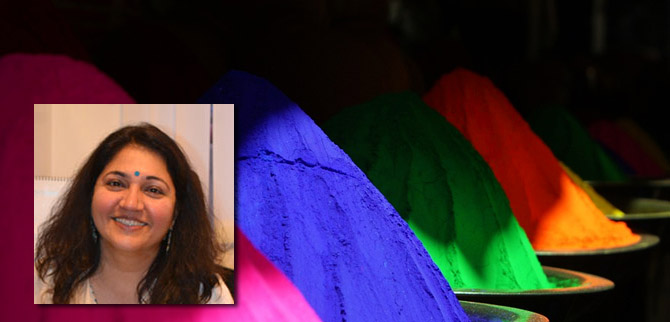Aarti David, Director, Publishing at SAGE India, in an interview with Live Encounters
Aarti David is Director, Publishing at SAGE India. She jointly heads books and journals commissioning along with marketing. As head of commissioning, she oversees all the streams SAGE publishes in English and Indian languages. This currently includes SAGE India Journals, SAGE India (Academic Books), SAGE Texts (Textbook publishing programme), SAGE Response (Business and Management Books), SAGE Select (Non-Fiction), SAGE Bhasha (Indian language publishing program), SAGE AdvantEDGE (educational resources programme), SAGE Vistaar (South Asian Rights Programme). Besides these, she is also responsible for managing the joint imprints with Yoda Press, Popular Prakashan, Stree, Samya and Vitasta.
 Tell us about the contribution of SAGE India towards the knowledge enrichment of the society and academia. Are the serious non-fiction books worth emulating? Is there a standard being set?
Tell us about the contribution of SAGE India towards the knowledge enrichment of the society and academia. Are the serious non-fiction books worth emulating? Is there a standard being set?
SAGE’s vision and mission has been dissemination of knowledge. Whether it has been in the academic space or in the non-fiction space. We believe that the content we produce should contribute to the society and with that intent alone our non-fiction publishing has taken shape. Our aim is to give scholarly voices a platform to reach out to a larger audience and build bridges to knowledge. Through our non-fiction publishing program SAGE Select, we wish to challenge outdated thoughts and social practices and present novel perspectives on changing world realities. We have a compelling list of titles on crucial subjects ranging from political debates across the Social Sciences to Gender and Sexuality studies; life stories, field studies, policy studies. Books that aim to unravel the politics of cultural hegemony as well as resistance and present a blend of real life stories and social issues viewed from a critical and progressive standpoint.
What is SAGE India’s publishing philosophy?
Our publishing philosophy is all about shepherding ideas from creation, to communication and critical understanding. We are proud to play a creative role in society by disseminating quality content that is associated with teaching, learning and research. And fearlessly capturing the critical and reigning issues of today’s world through our various imprints.
Tell us about the kind of books SAGE publishes? What is the driving force for your publishing decisions besides revenue?
SAGE publishes academic library books which include—reference books, handbooks, multi-volume sets; textbooks meant for the UG and PG level students, based on the UGC curriculum; Business and management books that are meant for students, entrepreneurs, HR heads, as well as practising managers who wish to find tools to succeed in their corporate journey; non-fiction books which effectively capture the non-mainstream and critical reality of contemporary India and/or Asia on various topics close to everyday life are aimed at the general, yet discerning and informed readers. And our Indian language publishing program-SAGE Bhasha was launched in 2015 with an aim to reach every strata of academia through cutting edge research that transcends boundaries in Indian languages.
While revenue plays an integral role in making any publishing successful, the primary driver for our publishing has been to support quality research that transforms society and our understanding of individuals, groups, and cultures. SAGE has perpetuated itself as an independent, innovative, natural home for scholars and educators who share our commitment and passion for the social sciences.
Every market is different as every author and reader is. How do you plan to handle all your stakeholders differently?
It is true that every market is different and every reader is too. And we ensure that we cater to each category of readership through our wide range of publishing across our various imprints. We also look into the buying potential of each individual category and try to ensure that our books are priced to market. In addition SAGE is known for its marketing and sales efforts globally. We leverage on these strengths to bring value to our stakeholders.
In 2015, SAGE India entered into partnerships with independent publishers to form new imprints. What was the thought behind this decision?
The idea to partner with independent publishers was to provide a wider reach to the co-partners and also to supplement our own existing list of titles. Each partner brings their unique flavour and strength to the program. To ensure we retain their originality and individuality, we have created a separate logo for each partner within the co-pub arrangement, while being published under the SAGE umbrella. It’s a mutually beneficial arrangement- where two entities with a common ideology are able to tie up with each other and leverage on each other’s strengths. We are all equally committed to make this a success.
How different or similar is books and journals publishing? What are the challenges or guiding principles that guide these commissioning decisions?
Publishing depends on credibility of the content and whether it is for a book or a journal, it is imperative that the research is adequately referenced and backed by evidence to support the claims of an author. It is also true that books and journals are as different as Chalk and Cheese. The business models for these are different and the publishing decisions too. While one would opt to publish a book on a certain issue/topic, it would need to be brought out within a specified time period ranging from six to eight months. Journals on the other hand publish in a certain kind of cycle and periodicity. Depending on the topicality/theme of the journal, these could be quarterly, bi-annual or annual. Reviews play a key role in journal publishing—articles/papers need to be peer reviewed and the credibility of a journal develops with timely publication; citations; high impact factor rankings, which in turn widen the reach and scope of the journal and also its readership base. The higher the ranking of the journal, the more respected it becomes. It is also quite commonplace to publish these in collaboration with societies. On the other hand, books can be published by stand alone authors who only need a publisher who believes in their work. Of course, both these publishing programs cannot be successful unless these are commercially viable. As a publisher, one walks the thin line between providing a platform to disseminate knowledge to a wide audience and also ensuring that to be successful, the approach that is followed is sustainable. Each journal has an independent board of editors. These ensure that the content is evaluated at arm’s length from the publisher’s standpoint. The independence of the board, even if the journal is owned by SAGE ensures that the benchmark is set high on quality and credibility.
Textbook market is hugely competitive. What makes SAGE stand apart?
SAGE has entered the textbook arena not just to dislodge the established players in the market, but to fill in where gaps exist. It is a very competitive market and yet, we believe that staying true to our larger goal of dissemination of knowledge and sticking to our core area of competence in publishing in the social sciences and business and management, we will be able to carve a niche for our program. We started our program in 2015 and though it is early days, we are quite bullish about the content we are publishing and the response that we have been receiving. SAGE Texts have been able to establish an identity in the market and that’s something we are proud of.
Considering SAGE is essentially a social sciences publisher, how do you see your movement towards STEM subjects shaping up in coming years?
Globally, SAGE has been publishing journals in STM and Engineering and in India too we have started exploring this field as a potential area of publishing. With Open Access the scope of publishing has only widened. We think that this could be a growth driver for us in the future. We don’t publish books in this area.
Open Access now is well established. Is SAGE India ready to go open access? How much of publishing currently is open access?
SAGE globally is already publishing Open Access journals and in India too we have started exploring opportunities for the same. OA publishing out of the India office is still at a nascent stage and we hope to build this in the coming years. Since this type of publishing adds greater responsibility with regards to the content, one has to ensure that the peer review mechanism is more stringent to avoid any plagiarism issues.
What is the response of the global audience to the content of SAGE India books?
Books focusing on South Asia or having a wider/more holistic approach tend to do better globally since they are able to connect to that audience. In addition, social issues, research, gender, sexuality, politics, caste based issues also find interest. We have been selling our content through the SAGE London and US offices since the India office began its publishing program and we continue to do so. Technology now allows us to reach markets that were earlier very difficult to service.
How do you see the publishing decisions shaping up over the years? Will there be room for original fiction and school books?
Publishing decisions largely depend on the target market, topicality/relevance and the commercial viability of the project. While we have moved into various types of publishing, we have always maintained to stay within the guidelines of our company’s vision. This is in clearly in the higher education space. At this point in time, it seems highly unlikely that we would foray into school books. As far as Fiction publishing is concerned, it is not our mandate to move into this type of publishing. I don’t see this happening at any time for SAGE.
What books have you read recently that you would recommend to readers of this interview?
I love reading all kinds of genres ranging from fiction to social issues to Archie comics. Not sure what I could recommend to readers but I would definitely like to share that I just finished reading Jerry Pinto’s brilliantly edited volume A Book of Light: When a Loved One has a Different Mind, which to me is a must read book to get some insight about mental health issues, especially in today’s stressful times, it opens new doors of understanding about this very relevant and most misunderstood issue.
Currently I’m reading Honor by Elif Shafak.
What would you like to suggest to authors who are just starting out?
I would simply say, stay true to your core and believe in yourself. You will find the right publisher for your work, just maintain the quality and credibility of your content.
SAGE has always provided a platform for budding authors provided they meet with certain basic criteria that make their manuscript worthy of publishing. For us content has always been king and will continue to be so. Today budding authors have choices that earlier they didn’t. Marketing and sales still play an important part in making a book successful but the online space has democratized this in many ways. It’s a great time to be an author and equally difficult to be a successful one.
© Live Encounters Magazine


